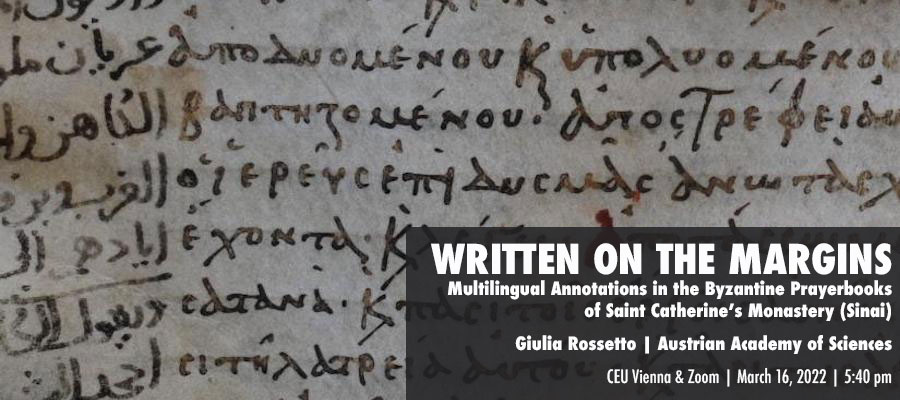Written on the Margins: Multilingual Annotations in the Byzantine Prayerbooks of Saint Catherine’s Monastery (Sinai), lecture by Giulia Rossetto (Austrian Academy of Sciences), CEU Vienna and Zoom, March 16, 2022, 5:40 pm
The Monastery of Saint Catherine in the Sinai Peninsula, built in the sixth century by order of Emperor Justinian I, holds one of the oldest and richest collection of manuscripts of the Christian East. Its library preserves handwritten books in twelve different languages including Arabic, Syriac and Georgian, but predominantly Greek. Among them are Byzantine Euchologia, prayer books reserved for bishops and priests, and essential for the celebration of all the services of the Byzantine Rite. However, they are not just liturgical books: Euchologia were used on a daily basis and were thoroughly annotated, frequently in languages other than the main text. These marginal annotations – so far largely ignored by scholars – conceal a considerable amount of valuable information. They help us to understand how far prayer books travelled, who were their possessors, carriers and users over the centuries, and how they adapted to their own needs the manuscripts’ structure and content.
Giulia Rossetto is post-doctoral researcher at the Austrian Academy of Sciences. Her research focuses on the study of Byzantine manuscripts as archaeological objects and on the mobility of books and the people who carry them, with a special interest in the movement of Greek manuscripts between Italy, Egypt, Palestine and Syria. Thanks to her affiliation with the Sinai Palimpsests Project, she has worked extensively on the Greek palimpsests of the Monastery of Saint Catherine (Sinai). Her first monograph, Greek Palimpsests at Saint Catherine’s Monastery (Sinai): Three Euchologia as Case Studies, stems from this work and will be published in the summer of 2022. Since December 2020, she is the PI of the project “Priests, Books and the Library at Saint Catherine’s (Sinai)," funded by the Austrian Research Fund (FWF).
